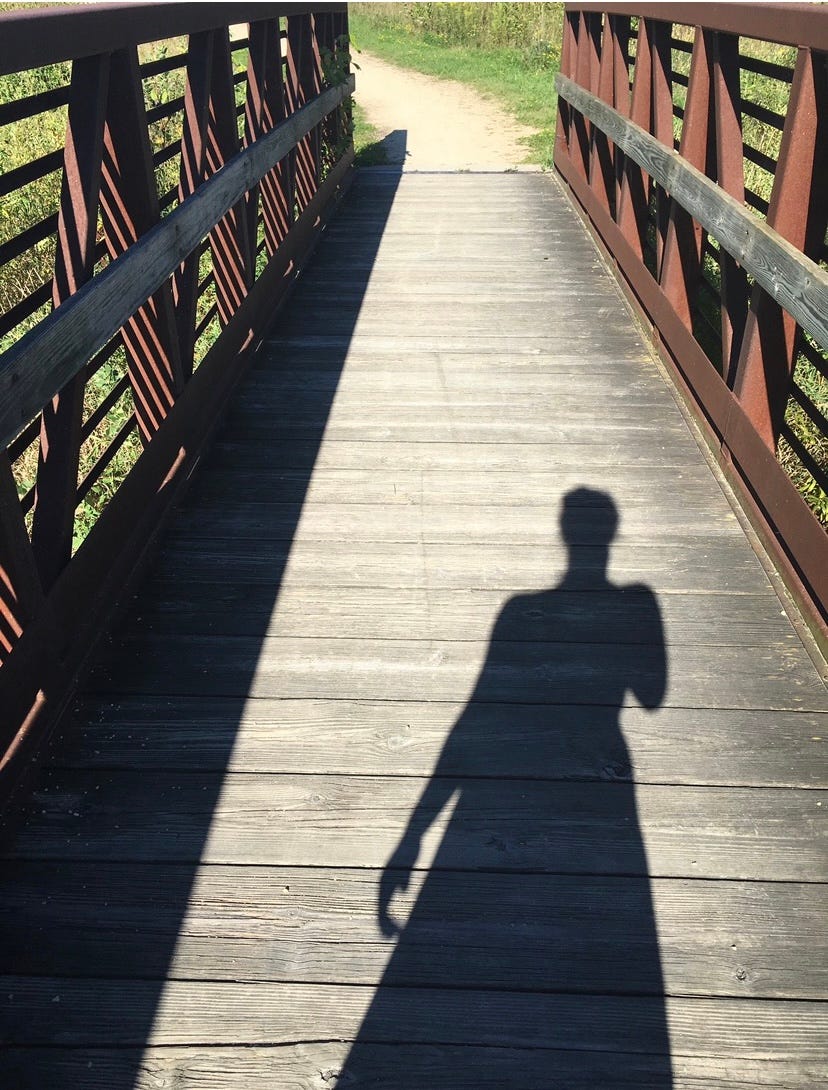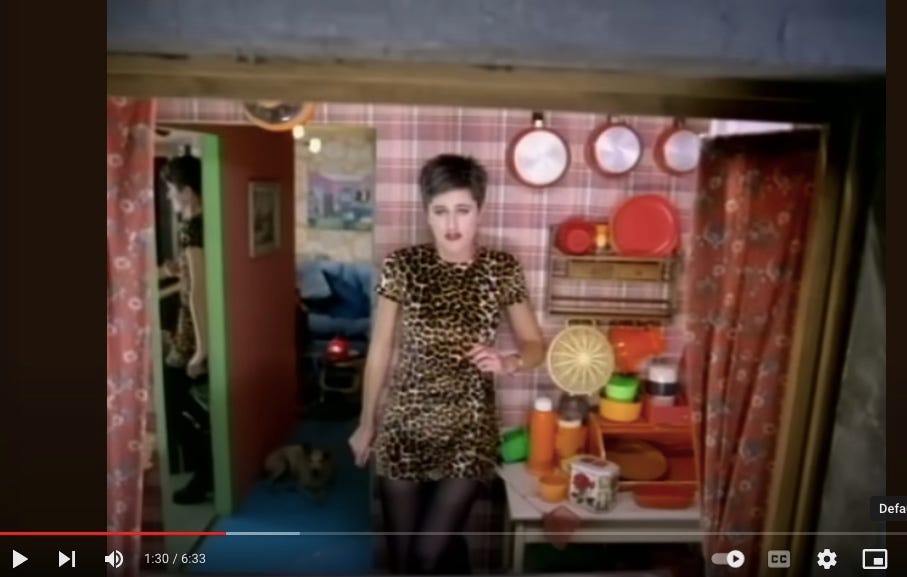📿 Protection is a Suit of Armor, Protection is a Sanctuary
My body is the most familiar place and completely foreign to me.
🎧 LISTEN TO ME READ THIS ESSAY, ABOVE.
Hello you, Adreanna here with this week’s dispatch of The Laundry —
Welp. Here I am, making my way back to my yoga practice again. The last time I made my way back to my yoga practice, I promptly blew out my right shoulder. I must have extended or twisted past my current capacity, mistaking my body for a more familiar, limber version of itself. I must have forgotten that my body is more feeble and unsteady now, while it’s still in the process of rebuilding.
“It’s the relaxin hormone,” my acupuncturist assured me while searching my armpit with her finger pads. Apparently the joints turn into jelly during pregnancy in order to accommodate the physical expansion. Sometimes those joints clamp shut in postpartum after the hormonal flood recedes.
My mind drifted to a nature documentary that I had seen once, as she inserted needles below my clavicle. I imagined my shoulder was akin to one of those giant bivalve shells that resemble a prehistoric clam. I remembered seeing an octopus contort its gelatinous body into the base of one of those, and then clamp the top shut around itself. “Protection,” I thought. This makes sense to me.
I sent my breath into my shoulder socket and reassured it that once it was ready to open again, I would do my best to keep it safe.
Coming back to my body after pregnancy has been like moving back into my lifelong home after a major renovation and finding that nothing is where I left it. The kitchen is where the bedroom used to be. The foundation has gone alarmingly soft in places and the structural beams are skewed out of alignment.
This is a real freaking bummer because it took the entire decade of my 30s to inhabit my body, to adorn the walls with love and acceptance after years of learning only how to objectify it. I learned to feed my body delicious treats after years of always being a little bit hungry. I learned how to move my body in delicious ways after years of posing for the gaze of others.
Coming back to my body after pregnancy has been like finding my glorious home that was loaned to my loved one was accidentally trashed in the process. There’s no blame or remorse, I’m glad that I did it, but there is incredible sadness.
The first month or so after pregnancy I chose not to move back into my body at all. I camped out somewhere adjacent to it— clocking in periodically when I was employed to make my body perform a function that required my conscious attention. I came to think of my body not as a residence, but as a kind of work facility; a utilitarian space that made life and sustained life— and was doing so rather efficiently.
I knew that when I moved back in, I would have to feel what it was like in here. Feeling would be a prerequisite to landing and staying and finding a sense of belonging in my skin. I would have to experience the wobbly instability of the structural beams and the atmosphere of discomfort. The exhaustion, the sleeplessness, the inflammation and the atrophy. These physical conditions can be perceived — but not experienced in full — as long as the body remains a facility. Like insulation wrapped around a steaming pipe, distance can also provide protection.
The morning I decided it was time to move back into my body, I unrolled my yoga mat and gingerly slid my hips back into child’s pose. I felt a gripping sensation through my shoulders and a warm wave of grief break over my lower back. As the tension began to peak and release, I gave myself over to the sensations. I breathed and wept for my exhaustion and for my physical pain, and I wept for the irrevocable change in my body. I wept for my baby and how small and vulnerable she is and the volatile future she’s set up to inherit. I wept for the countless others who don’t feel at home in their bodies and the painful circumstances that have made it so.
I returned to my body day over day over day over day, moving slower than I’ve ever wanted to. Accepting whatever it offered me. Breathing love into the rickety structural beams. Protecting my body by confirming it.
There’s a mode of protection that’s synonymous with defense. When I consider protection this way, I think of shields. Armor. Walls. Security. And the motivation of self preservation. It’s the octopus in the bivalve shell. It’s my shoulder clamping shut under distress. It’s the distance created between myself and my body as a means of locking out my discomfort.
There’s nothing wrong with this kind of protection— just the opposite. I would say that there are circumstances in which a shield is the most skillful response to prevent further injury or flooding the nervous system.
And also, it’s not the most pleasant place to live (if we can help it) — with our shields up behind the wall of the facility. It’s possible that the tenderness that we’re aiming to protect becomes a prisoner behind our defenses.
As Pema Chodron wrote in When Things Fall Apart:
“When we protect ourselves so we won't feel pain, that protection becomes like armor, like armor that imprisons the softness of of the heart.”
There’s another mode of protection I’ve been considering that’s more closely related to care. I think of this mode of protection as sanctuary. Shelter. Tending to. Support. If protection as defense keeps the unwanted out, then perhaps protection as care invites the vulnerable in. I think of environmentalists encouraging us to put our hands in the earth and feel our feet in the grass because we’re prone to protecting what we love. It’s breathing into a wounded shoulder and treating it gently while it heals on its own timeline. It’s allowing the softness of the heart to be soft as a tradeoff for staying with the pain.
The word “protection” stems from the Latin verb “protegere” which means: to cover in front. A suit of armor covers the body in the front. So does a soft blanket that we might drape over a loved one who fell asleep on the couch.
So here I am, making my way back to my yoga practice— again. And again. And again. I’m feeling where my thresholds are and (despite my ambition) dialing everything back a few degrees to protect my body as it rebuilds itself.
A few days ago at the studio in town my eyes caught a little wobbly insect careening towards my mat. It had wings, but seemed unable to fly. I watched it approaching me and stopped mid-flow to usher it across the room. I built a little wall across the side of my mat with cork yoga blocks just in case it turned back towards me. It’s not that I was shielding myself from the presence of the insect. I just didn’t want it to get hurt, or worse, if it wobbled across my mat. “Protection,” I thought, as I gently pressed my own wobbly body back into down dog.
May we all feel at home in our bodies.
POST SCRIPT:
Thank you, truly, for reading along with us here at The Laundry. I know how valuable your attention is and the fact that you offer it to the writing that we do here means the world. I hope that you get something out of it in return, because - RECIPROCITY is everything.
Often when I’m writing The Laundry, I’ll get a corresponding song stuck in my head because my brain is made up of 38% song lyrics. I’ve recently started posting these songs in post script, in case you want to sing along, too. This one emerged from the depths of one of my high school mix tapes.
Enjoy the very good 90s vibes and Michele Gondry filmmaking. 👌🏾












Dear Adreanna, your insights about our bodies strikes a real cord with me because I can apply it to aging so completely. Whether it is an adjustment to needing hearing devices or waking up with stiff joints, not to mention the urge to take a late afternoon nap, my body is indeed "a most familiar place and completely foreign to me" in my seventies. Yoga helps as does meditation but it is a never ending boomer battle. Many many thanks for your poignant and always wise thoughts.
Protection as armor vs. protection as shelter. I'm going to be meditating on this all week now. And wow, I'd never seen the Gondry music video linked here, but it's beautiful too. Thankful for all of it.